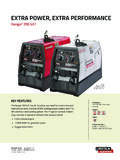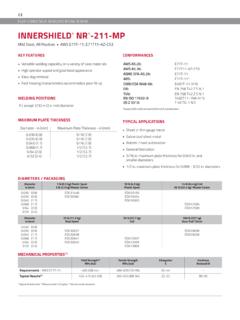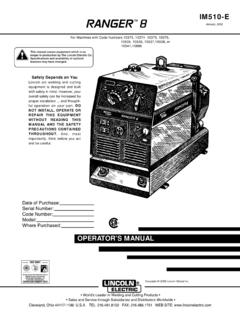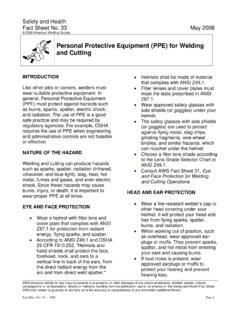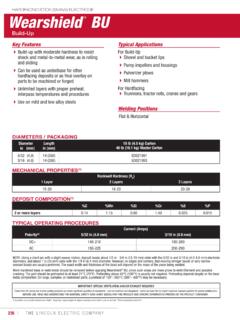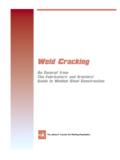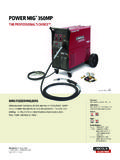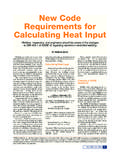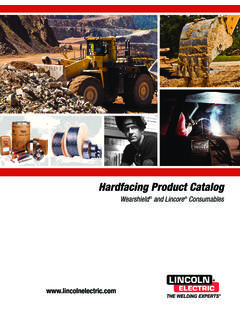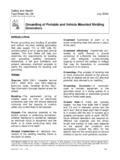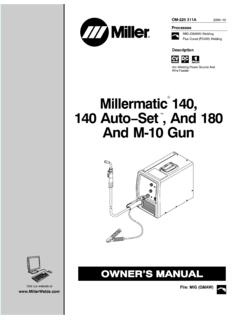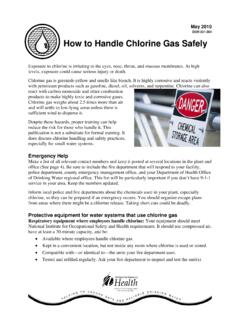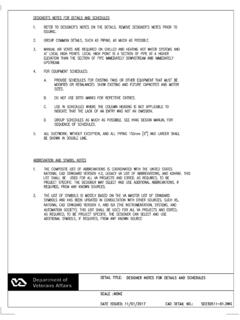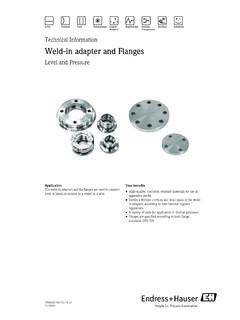Transcription of Welding Guide LEARNING TO STICK WELD - Lincoln Electric
1 Welding Guide LEARNING TO STICK weld . Refer to for additional safety information. Welding Safety Interactive Web Guide for mobile devices LTW2 | Issue Date 07/13. Lincoln Global, Inc. All Rights Reserved. Safety DepenDS on you Keep youR heaD out of the fumeS. The serviceability of a product or structure utilizing this type of DON'T get too close to the arc. Use information is and must be the sole responsibility of the builder/user. corrective lenses if necessary to Many variables beyond the control of The Lincoln Electric Company stay a reasonable distance away affect the results obtained in applying this type of information.
2 These from the arc. variables include, but are not limited to, Welding procedure, plate chemistry and temperature, weldment design, fabrication methods, READ and obey the Material Safety and service requirements. Data Sheet (MSDS) and the warning label that appears on all containers of Welding materials. USE ENOUGH VENTILATION or WARNING exhaust at the arc, or both, to keep the fumes and gases from your breathing zone and the general area. This statement appears where the information must be followed IN A LARGE ROOM OR OUTDOORS, natural ventilation may be exactly to avoid serious personal injury or loss of life.
3 Adequate if you keep your head out of the fumes (see below). USE NATURAL DRAFTS or fans to keep the fumes away from your CAUTION face. If you develop unusual symptoms, see your supervisor. Perhaps the This statement appears where the information must be followed to Welding atmosphere and ventilation system should be checked. avoid minor personal injury or damage to this equipment. weaR coRRect eye, eaR & boDy pRotection PROTECT your eyes and face with Welding helmet properly fitted and with proper grade of filter plate (See ANSI ). PROTECT your body from Welding spatter and arc flash with protective clothing including woolen clothing, flame-proof apron and gloves, leather leggings, and high boots.
4 PROTECT others from splatter, flash, and glare with protective screens or barriers. IN SOME AREAS, protection from noise may be appropriate. BE SURE protective equipment is in good condition. ALSO, WEAR SAFETY GLASSES IN WORK. AREA AT ALL TIMES. SpeciaL SituationS. DO NOT weld OR CUT containers or materials which have previously been in contact with hazardous substances unless they are properly cleaned. This is extremely dangerous. DO NOT weld OR CUT painted or plated parts unless special precautions with ventilation have been taken. They can release highly toxic fumes or gases.
5 Additional precautionary measures PROTECT compressed gas cylinders from excessive heat, mechanical shocks, and arcs; fasten cylinders so they cannot fall. BE SURE cylinders are never grounded or part of an electrical circuit. REMOVE all potential fire hazards from Welding area. ALWAYS HAVE FIRE FIGHTING EQUIPMENT READY FOR. IMMEDIATE USE AND KNOW HOW TO USE IT. LEARNING TO STICK weld . TABLE OF CONTENTS. Page Learn to STICK weld ..1. Arc Welding What Happens in the Arc ..1. Correct Welding Correct Way to Strike an Arc ..2. Correct Arc Length ..2. Practice ..3. Common Joint Types and Butt Penetration.
6 4. Fillet Multi Pass Welds ..5. Welding in the Vertical Position ..5. Vertical-Up Welding ..5. Vertical-Down Welding ..5. Overhead Welding ..6. Welding Sheet Hardfacing ..6. How to hardface the Sharp Hardfacing of Idler and Roller ..7. Welding Cast Iron ..7. Cast Iron Plate Preparation ..8. 3. LEARNING TO STICK weld . LEARNING TO STICK weld What Happens in the Arc? Figure 2 illustrates the action that takes place in the Electric arc. It No one can learn to weld simply by reading about it. Skill closely resembles what is actually seen during Welding . comes only with practice. The following pages will help the inexperienced welder to understand Welding and develop his skill.
7 For more detailed information, order a copy of New Lessons in Arc Welding , available from the James F. Lincoln Foundation. the aRc- Welding ciRcuit The operator's knowledge of arc Welding must go beyond the arc itself. If you want to get the most out of your Welding practice, your knowledge of Welding must go beyond the arc. You also need to FIGURE 2 The Welding arc understand how to control the arc, and this requires knowledge of the Welding circuit and the equipment that provides the Electric current used in the arc. Figure 1 is a diagram of the Welding circuit. The The arc stream'' is seen in the middle of the picture.
8 This is the circuit begins where the electrode cable is attached to the Welding Electric arc created by the Electric current flowing through the space machine and ends where the work cable is attached to the Welding between the end of the electrode and the work. The temperature of machine. Current flows through the electrode cable to the electrode this arc is about 6000 F. (3315 C.), which is more than enough to holder, through the holder to the electrode and across the arc. On the melt metal. The arc is both very bright and very hot. If you look at the work side of the arc, the current flows through base metal to the work arc with your naked eye, you risk several hours' or days' worth of cable and back to the Welding machine.
9 The circuit must be complete pain and poor, blurry vision. A Welding helmet with a very dark lens, for the current to flow. To weld , the work clamp must be tightly specifically designed for arc Welding , must be used whenever viewing connected to clean base metal. Remove paint, rust, etc. as necessary the arc. to get a good connection. connect the work clamp as close as possible to the area you wish to weld . Avoid allowing the Welding Have you ever watched water flow from a garden hose onto soft soil circuit to pass through hinges, bearings, electronic components or or earth? Eventually, the water will build up enough to displace and similar devices that can be damaged.
10 Dig into the soil beneath it. It may even form a small crater that then fills with water. The arc works the same way, melting the base metal This arc- Welding circuit has a voltage output of up to 79 volts, which and actually digging into it as it moves across the surface of the base is enough to shock. metal. The molten metal forms a molten pool or crater and tends to The Electric arc is made between the work and the tip end of a small flow away from the arc. As it moves away from the arc, it cools and metal wire - the electrode - which is clamped in a holder. The holder solidifies.
